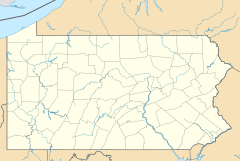Radisson Lackawanna Station Hotel
| Radisson Lackawanna Station Hotel | |
|---|---|
 |
|
| Former names | Delaware, Lackawanna and Western Railroad Station |
| General information | |
| Type | Hotel |
| Architectural style | Neoclassical |
| Location | 700 Lackawanna Avenue Scranton, Pennsylvania United States |
| Coordinates | 41°24′21.7″N 75°39′43.6″W / 41.406028°N 75.662111°WCoordinates: 41°24′21.7″N 75°39′43.6″W / 41.406028°N 75.662111°W |
| Completed | 1908 |
| Renovated | 1982–1983 |
| Cost | $600,000 |
| Affiliation | Radisson |
| Technical details | |
| Floor count | 6 |
| Design and construction | |
| Architect | Kenneth MacKenzie Murchison |
| Website | |
| www |
|
| Official name | Delaware, Lackawanna and Western Railroad Station |
| Designated | December 6, 1977 |
| Reference no. | 77001170 |
The Radisson Lackawanna Station Hotel, built as the Delaware, Lackawanna and Western Railroad Station, is a neoclassical building in Scranton, Pennsylvania. It was built as a train station and office building in 1908; closed in 1970; listed on the U.S. National Register of Historic Places on December 6, 1977; and renovated and reopened as a hotel in 1983.
The building retains its original clocks, doors, fountains, stairs, ceilings, walls, and overall appearance.
In the early 1900s, Delaware, Lackawanna and Western Railroad president William Truesdale approved a plan to replace the railroad's Scranton station, an old brick structure located on Lackawanna Avenue near Franklin Avenue. The new station, to be built about seven blocks east at 700 Lackawanna Avenue, would be a far grander structure that would also house the railroad's offices, with the exception of the executive offices in New York City. The railroad commissioned New York architect Kenneth Murchison, who executed the design in French Renaissance style.
Constructed of brick and steel at a cost of around $600,000, it has concrete floors and partitions. The exterior is faced with Indiana limestone and it has an 8-foot bronze clock on the façade. The main entrance leading to the former waiting room is furnished in Formosa, a soft, pinkish-yellow Italian marble. Its Grand Lobby, two and a half stories tall, has an ornamented mosaic tile floor, a barrel-vaulted Tiffany stained-glass ceiling, rare Siena marble walls, and 36 unique Grueby Faience tile murals. The tiles are styled after the work of American artist Clark Greenwood Voorhees, and represent scenes along the DL&W's Phoebe Snow main line from Hoboken, N.J., to Buffalo, N.Y.
...
Wikipedia

